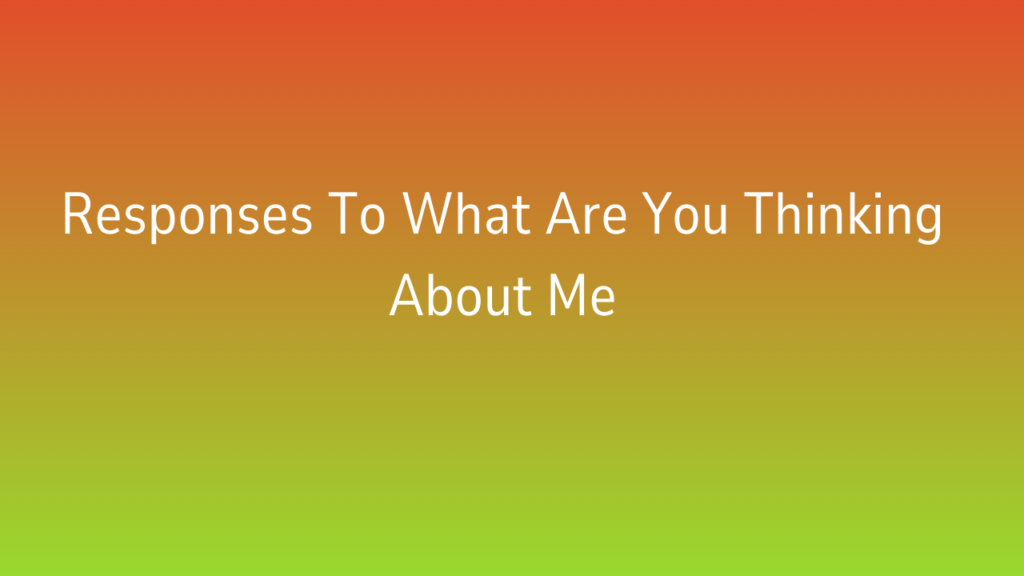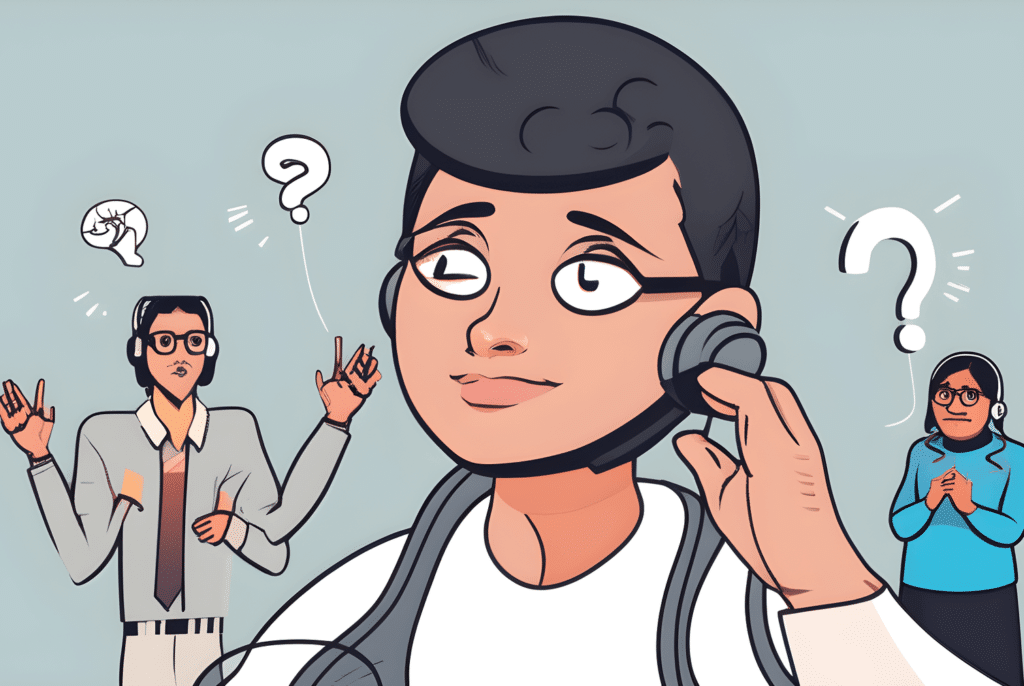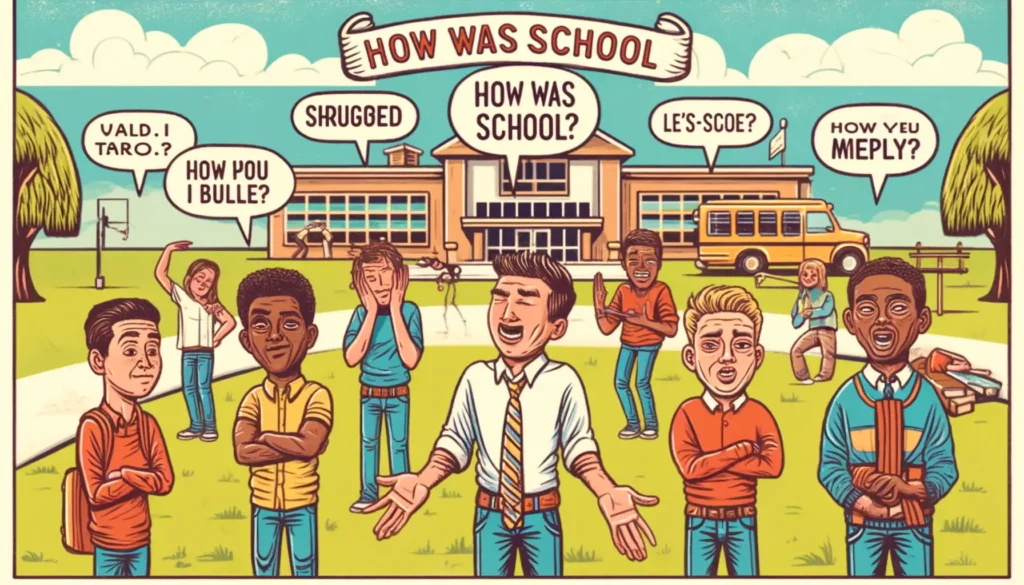When someone asks you, “What are you thinking about me?” it can catch you off guard, especially if you weren’t expecting such a personal question. Whether you’re on a date, talking to a crush, or in the midst of a deep conversation with someone you care about, this question can be tricky. It can make you feel vulnerable, but it also opens the door to expressing your thoughts, feelings, and intentions.
The way you respond to this question can have a significant impact on your relationship with that person, whether it’s romantic, platonic, or somewhere in between. Your response could convey your level of interest, affection, or even confusion. So, how do you navigate this situation with grace, humor, or sincerity?
In this blog post, we’ll explore several different responses to the question, “What are you thinking about me?” We’ll provide a variety of examples based on different contexts and situations, discuss how to deliver your response confidently, and give you some helpful tips on knowing when to be honest, flirty, or even mysterious.
Understanding the Question: “What Are You Thinking About Me?”
Before we get into specific responses, it’s important to understand why someone might ask, “What are you thinking about me?” This question typically comes from a place of curiosity or vulnerability. The person asking wants to know how you perceive them. This can be in the context of:
- Romantic interest: They might be wondering if you’re thinking about them in a romantic way, especially if there’s already some attraction between you.
- Building connection: In a developing relationship, someone might ask this question to gauge your thoughts and feelings about them.
- Flirtation: Sometimes, this question can be playful or flirtatious, especially in early dating stages.
- Seeking reassurance: They may want validation, wanting to hear that you think positively of them.
The tone of the question and the context of your relationship with the person can greatly affect how you should respond.
Types of Responses to “What Are You Thinking About Me?”
The way you respond depends on your feelings for the person and the context in which the question is asked. Let’s break down several types of responses to this question and explore when to use each one.
1. Honest and Sincere Responses
If you feel comfortable sharing your true thoughts and emotions, this can be a great opportunity to deepen the connection. Being honest about your feelings can show that you trust the person and want to build a stronger bond.
- “I’m thinking about how much I enjoy spending time with you.”
- A sweet and sincere response that shows you appreciate their company.
- “Honestly, I’m thinking that you’re a really interesting person.”
- A response that expresses your admiration in a genuine way without necessarily focusing on romantic attraction.
- “I’m thinking that I like getting to know you more.”
- If you’re still in the early stages of getting to know someone, this response is a perfect balance of honesty and curiosity about the other person.
- “I’m thinking you’re someone I’d like to spend more time with.”
- If you’re interested in pursuing something more, this is a straightforward yet warm response that shows clear intention.
- “I’m thinking that you make me laugh a lot, and I really appreciate that.”
- A great response for when you admire someone’s sense of humor or personality.
These responses work best when you feel confident about your emotions and want to express them openly. However, they are also appropriate if you’re unsure about the other person’s feelings but still want to show you’re interested in getting to know them.
2. Flirty Responses
If you’re in a playful, flirtatious situation, then answering with a flirty tone can keep the conversation light and fun. Flirting helps you show interest while keeping things exciting and unpredictable.
- “I’m thinking about how much I want to kiss you right now.”
- A direct, bold, and flirtatious answer, suitable if there’s mutual attraction and the mood is right.
- “I’m thinking that you’ve got my attention, and it’s hard to focus on anything else.”
- This response implies that you’re smitten and can lead to a fun back-and-forth.
- “I’m thinking about how cute you look right now.”
- A compliment mixed with a flirtatious edge. It shows that you’re attracted to the person without overdoing it.
- “I’m thinking that I’m really glad you asked me that question!”
- This response is lighthearted and flirty, leaving some room for more playful exchange.
- “I’m thinking I’m lucky to be in the presence of someone as amazing as you.”
- This response shows admiration while keeping the mood fun and flirty.
Flirty responses are ideal when you want to keep the conversation playful and build attraction. They help create a fun atmosphere without diving too deep into heavy emotions.
3. Mysterious or Vague Responses
If you’re not ready to reveal too much or just want to keep the other person guessing, responding with mystery can be an intriguing way to engage them without giving everything away.
- “I’m thinking about how there’s so much I could say, but I’m not sure where to start.”
- This adds a layer of intrigue, suggesting that you have more to share but aren’t ready to reveal everything.
- “I’m thinking that maybe you’ll find out soon enough.”
- A playful, teasing response that keeps the conversation going and makes the other person wonder what you’re really thinking.
- “I’m thinking that I like to keep some things to myself.”
- This response signals that you’re not quite ready to open up completely, maintaining an air of mystery.
- “You’re making me think about a lot of things right now.”
- A non-committal response that implies you’re reflecting on your feelings or thoughts but prefer to keep them private for now.
- “I’m thinking that you might have to wait to find out.”
- A teasing response that leaves the other person curious and intrigued about your feelings.
These types of responses work well when you want to keep the interaction light or when you’re not ready to express your full feelings yet. They keep the conversation going while making the other person more curious about your thoughts.
4. Humorous Responses
Sometimes, humor is the best way to respond, especially if you’re looking to keep the situation lighthearted and fun. Humor can help defuse any tension and make the interaction more enjoyable.
- “I’m thinking about how you’re making me nervous with that question!”
- This playful response can break the ice and show that you’re not taking things too seriously.
- “I’m thinking about how I need to stop making things so complicated.”
- A humorous, self-deprecating response that shows you’re not overly concerned with the situation.
- “I’m thinking that I’m glad you’re asking me this instead of ‘What are you thinking about right now?’”
- This clever answer brings some levity to the conversation while still addressing their question.
- “I’m thinking about what I’m having for lunch tomorrow, actually.”
- A quirky and unexpected response that lightens the mood, especially if the question feels a bit too serious.
- “I’m thinking that this is definitely an interesting conversation.”
- This answer brings a humorous touch while acknowledging that the question is a bit out of the ordinary.
Humorous responses work well when you want to keep things light or when you sense that the situation doesn’t require a serious answer. It’s a great way to avoid awkwardness or make someone laugh.
5. Indirect Responses
If you’re unsure of what to say or simply don’t want to reveal too much, an indirect response can help you avoid the question without completely shutting down the conversation.
- “I’m thinking that it’s nice to be around someone like you.”
- A neutral response that doesn’t fully give away your thoughts but shows you appreciate their presence.
- “I’m thinking that I’d rather hear what you think about me first!”
- This response shifts the focus back to the other person, giving them a chance to express themselves first.
- “I’m thinking about how interesting our conversations have been lately.”
- This response keeps things positive but doesn’t specifically address how you feel about them.
- “I’m thinking about how I’ve enjoyed our time together so far.”
- A non-committal yet positive response that shows you’re engaged but not yet ready to share deep thoughts.
- “I’m thinking that it’s always interesting to know what someone else thinks about you.”
- This response turns the question into a broader discussion, subtly avoiding direct revelation of your feelings.
Indirect responses are best used when you don’t want to give too much away or aren’t ready to reveal your thoughts yet.
Tips for Crafting the Perfect Response
- Be Genuine: Whether you choose to be honest, flirty, or humorous, ensure your response feels authentic to who you are. Don’t try to say something you don’t believe, as this can come across as insincere.
- Consider the Context: The setting of the conversation is crucial. If you’re on a romantic date, you may want to give a sincere or flirtatious response. If you’re just getting to know someone, you might lean more toward a humorous or mysterious answer.
- Gauge the Other Person’s Expectations: If the other person seems
- Don’t Overthink It: The most important thing is not to stress too much over the question. Whether your response is perfect or not, it’s more about creating an engaging, authentic conversation.
- Know When to Be Direct or Playful: Depending on your comfort level with the person, decide whether to give a direct answer or a playful one. Both types of responses can be effective, depending on the context.
Conclusion
When someone asks, “What are you thinking about me?” it’s a question that opens the door to many possible responses. Whether you’re in a playful, flirtatious moment or a serious conversation, your answer can shape the way the conversation evolves and influence your relationship with that person. By considering the context, your level of comfort, and the tone of the conversation, you can craft a response that is genuine, charming, or mysterious.
Whether you choose to be funny, sincere, or a little bit mysterious, remember that the key is to be yourself and respond in a way that reflects your true feelings and personality.



